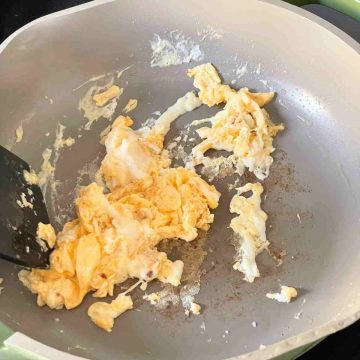Kikurage is an edible mushroom and a popular condiment in Japanese ramen noodles. It is also commonly known as wood ear mushroom, black fungus, jelly ear, jew's ear, and Mu Er in Chinese. Known for its nutritious value, below are 2 easy recipes and instructions for preparing the cloud ear mushroom.
The edible mushroom, kikurage, is named for its resemblance to an ear. It has a smooth surface on both sides and is dark brown in colour. Raw wood ear mushrooms carry a light woody fragrance. Once cooked, the mushroom is gelatinous and easily absorbs the flavours in the dish.
Widely consumed in Japan and China, it is often eaten cold in a salad or cut into matchsticks and served in ramen.

Jump to:

How To Prepare Kikurage?
To rehydrate wood ear mushrooms, we soak the kikurage in cold water mixed with cornstarch or plain flour and salt.
Here are the rough measurements we use for 1 cup of mushrooms.
- 4 cups of water
- 1 tablespoon of cornstarch
- 2 teaspoons of salt
Let it soak in the mixture for about 30 minutes.

Then, using your hands, rub the surface of the mushrooms to clean any dirt sticking to the surfaces. Pour out the water and refill the pot with clean water. Let it soak for another 20 minutes or longer.

The wild mushrooms can expand 3-4 times in size. So, if you plan to cook 1 cup of kikurage, rehydrate about ⅓ cup as they expand.
Soak the dried kikurage in warm water for 20 minutes for faster results. However, the mushrooms will not expand as much and will be less crunchy. Once rehydrated, store in the fridge and consume within 1-2 days.
Chinese Wood Ear Mushroom Salad

Ingredients
- 1 cup of Wood Ear Mushroom
- 1 tablespoon of sesame oil
- 1 tablespoon of vinegar
- 3 cloves of garlic
- ½ tablespoon of Oyster sauce
- 1 – 2 Red or green chilli (optional)
- 2 – 3 stalks of coriander (optional)
- Salt (optional)
Method
- Boil the soaked mushrooms for about 2 minutes. After cooking, remove it and place it in cold water to cool.
- Grate the garlic into a paste and combine with sesame oil, vinegar, light soy sauce, and oyster sauce. Add chopped red or green chilli and salt to taste.

Stir Fry Kikurage with Scrambled Eggs and Peppers
Ingredients
- 1 cup wood ear mushrooms rehyrdated and washed
- 3 Eggs
- ½ green pepper sliced
- 2 spring onions separate white and green parts
- 1 clove garlic minced
- 2 tablespoon light soy sauce
- 1 tablespoon rice vinegar
- 1 tablespoon oyster sauce
- 1 tablespoon sugar
- 1 tablespoon cornstarch
- 2 tablespoon water
- 2 tablespoon vegetable oil
- salt to taste
Instructions
- Soak the wild mushrooms in advance. Cut the green peppers into matchsticks, and chop the spring onions, separating the white and green parts.

- To make the sauce, combine the cooking wine, light soy sauce, vinegar, oyster sauce, white sugar, cornstarch, and water in a bowl and set aside.

- In a separate bowl, beat the eggs until well-mixed.

- Heat the pan on medium heat, add half of the oil, and once the oil is hot, add the eggs and stir fry until mostly cooked and fluffy. Remove from the pan and put aside.

- Add the rest of the oil, and once the oil is hot, sauté the white part of the green onions and minced garlic until fragrant.

- Add the green peppers and kikurage and stir fry for a few minutes. Then, push the vegetables to the side of the pan, lower the heat and pour in the sauce mixture. Once the sauce mixture thickens, add the scrambled eggs and stir to mix well. Serve while it's still hot.

Nutrition
Calories have been calculated using an online calculator. Nutritional information offered on Honest Food Talks is for general information purposes and is only a rough estimate.
Health Benefits Of Wood Ear Mushroom
Black Fungus is low in calories and fat content and high in fibre. The wild mushroom is packed with antioxidants and has high iron content. Kikurage can improve iron deficiency, reduce inflammation, lower cholesterol levels, and promote gut health.
In traditional Chinese medicine, black fungus is believed to have immune-enhancing and antimicrobial properties.
Where To Buy Wood Ear Mushroom?
You will often find dried kikurage in Asian supermarkets, which you must rehydrate before cooking. You can also find dried wood ear mushrooms online and in more miniature packs.

Two types of black fungus are often eaten. One is the hairy black fungus with a smooth inner surface that presents a dark brown colour, with an outer surface that's grey or greyish brown. The other is the wood ear mushroom, which is more commonly seen on the market.
The hairy black fungus is larger in size, but the texture is rough, and it's not easy to chew. Meanwhile, the wood ear mushrooms are softer, easier to chew, and refreshing.For more uncommon vegetables, see our guide on mooli, a white radish.

Julie Wong
In Cantonese, the one with the two colours and is thicker in texture is the wood ear, the softer, all black one is called cloud ears.
Honest Food Talks
That's very interesting to know!
Monica L.
Grew up eating these with my Cantonese grandpa! Best stuff!